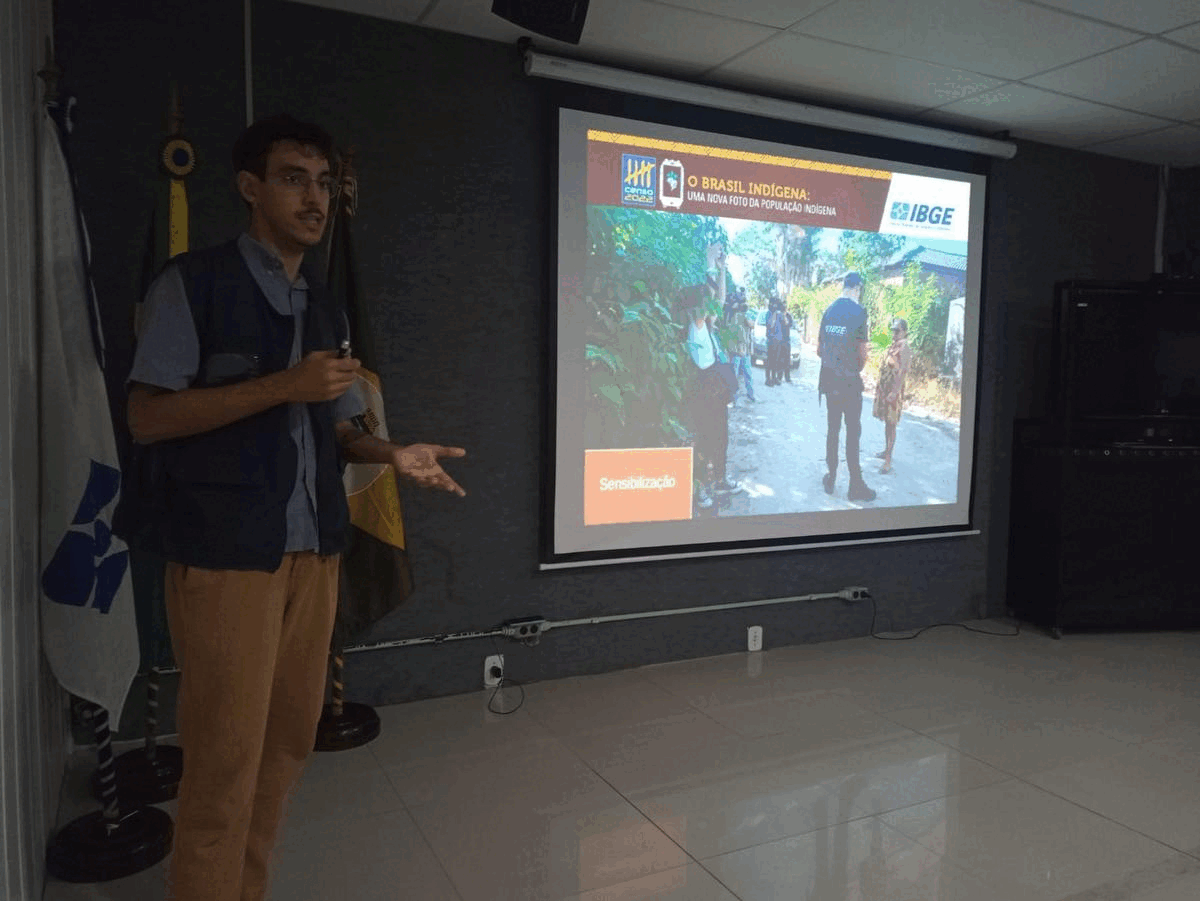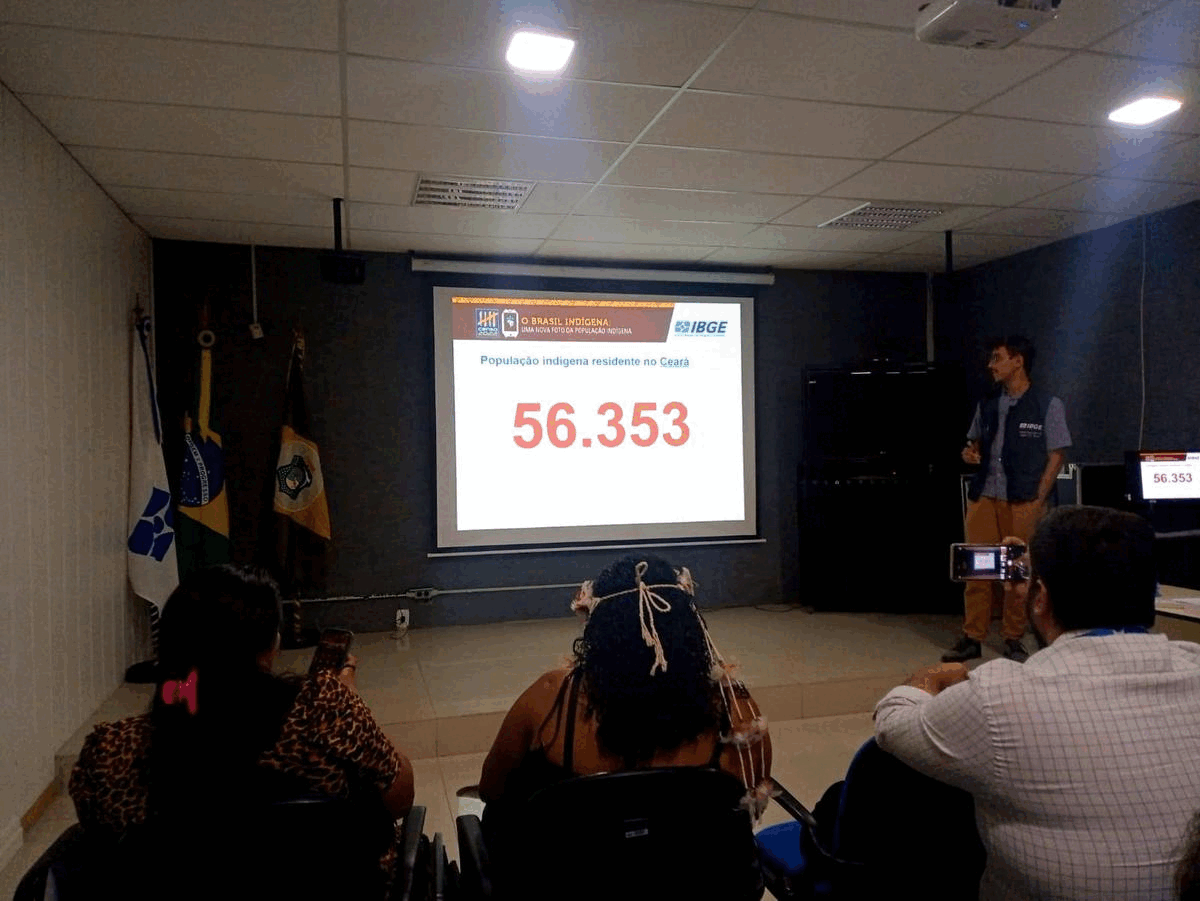SES-CE presents to institutions and leaders the first results of the 2022 Census on indigenous persons in Ceará
August 16, 2023 11h41 | Last Updated: August 17, 2023 16h19
The afternoon of August 7 was marked by one more event to release the results of the 2022 Population Census in the headquarters of the IBGE State Superintendence in Ceará (SES-CE). After the quilombolas, released on July 27, it is time to release the first data on the Indigenous Peoples. Organized by the sector of Information Dissemination and Documentation (SDI), the event counted with the presence of IBGE officers, as well as of indigenous leaders and representatives of institutions, whose cooperation was key to enumerate the indigenous people in the state.
The presentation was once again carried out by Fábio Jota, an anthropologist and Census Analyst of Traditional Peoples and Communities, who pointed out the innovations introduced in all the steps of the enumeration of the indigenous people, explained the major concepts and definitions used to support the work, and presented the data themselves, related to the population and households. “It is the result of an articulation at different levels: it helped the IBGE to improve the methodology and, at the same time, met a major self-identification. Now we obtained an information much closer to the reality of the indigenous population in the state,” noted the anthropologist, mentioning an increase of nearly three times in the number of indigenous persons in Ceará between 2010 and 2022.

The presentation of the data on indigenous persons in Ceará was carried out by anthropologist and analyst Fábio Jota
Leaders and institutions celebrate the data shown
The indigenous leaders who watched the presentation of the data were Naara Tapeba, Vice-Coordinator of the Federation of Indigenous Peoples and Organizations of Ceará (Fepoince) and member of the Organization of Indigenous Teachers of Ceará (Oprince), and Marciane Tapeba, Executive-Secretary of the District Council of Indigenous Health of Ceará (Condisi-CE/Sesai) and member of the Coordination of Articulation of Indigenous Women of Ceará (Amice). “As an indigenous movement, it is very important to know all these data, which should be accessed by the leaders. But it is also a challenge for the public policy itself to think how it would be organized based on these data,” stated Marciane Tapeba, who works in these two fronts with the indigenous people.
Also representing the Special Secretariat of Indigenous Health (Sesai), Lucas Guerra, Coordinator of the Special Indigenous Health District of Ceará (Dsei-CE), highlighted the utility of the data for the work of his institution: “Census is a survey that helps to qualify public policies. Indigenous health is a collective effort of leaders and managers, so it might represent an attendance to health, sanitation and supply in these territories.” The coordinator also highlighted that, despite the significant increase in the number of indigenous persons in Ceará, this population is still invisible in the state: “Self-identification is still a hard process for most people, and it shows how much it is challenging for us, who work in public policies, to understand that this process will occur often and it will demand attendance.”
Valdenia Lucena, of the National Foundation of Indigenous Peoples (Funai), reminded the historical invisibility of the indigenous persons in the state as well: “Before coming to Ceará, I heard many people saying that the state didn´t have indigenous persons, even authorities and savvy persons. So I see that this advance [in the numbers] is due to the indigenous movement itself. Both Valdenia Lucena and Bruno Dias, officers of the Regional Coordination Northeast II of Funai, involving the states of Ceará, Piauí and Rio Grande do Norte, took part in the presentation. They were very satisfied with the data already released by the IBGE, which will especially help their office.

Leaders, institutions and press were very interested in the data provided by the IBGE
First results on indigenous population and households
On Monday August 7, the IBGE released the First Results of the 2022 Population Census for the Indigenous Population. According to the data, Ceará has 56,353 indigenous persons, the equivalent to 3.33% of the total number of indigenous persons in Brazil and to 10.66% of the entire Northeast Region. Therefore, the state ranks in the ninth position among the Federation Units in terms of indigenous population. The indigenous population nearly tripled in Ceará between 2010 and 2022. The percentage of indigenous persons in the resident population of the state also grew: it changed from 0.24% in 2010 to 0.64% in 2022.

The first data of the 2022 Census show a number nearly three times higher of indigenous persons in Ceará
The indigenous population is present in 173 out of 184 municipalities in Ceará (94% of the total), and it represents 0.64% of the resident population of the state. The five municipalities in Ceará with more indigenous persons are, respectively: Caucaia (17,628 indigenous persons), Itarema (5,115), Maracanaú (5,111), Fortaleza (4,948) and Monsenhor Tabosa (4,861). On the other hand, the five municipalities in Ceará with the highest proportion of indigenous persons among the resident population are, respectively: Monsenhor Tabosa (28.35% of the inhabitants of the municipality), Poranga (12.78%), Itarema (11.97%), Aratuba (7.25%) and Carnaubal (5.03%).
Ceará has a total of 24,192 households with at least one indigenous resident, which represents 0.80% of the total number of households in the state. In the households in Ceará in which at least one indigenous person lives, the average number of residents is 3.21. It is worth highlighting that this average is above the average number of residents per household in the state (2.90) and in Brazil (2.79), which points out that households with indigenous persons usually have a larger number of persons living. Another important information is that, in the households in Ceará with at least one indigenous person, the indigenous presence is very high: 72.26% of the residents self-declare as indigenous persons.
There are seven Indigenous Lands (TIs) officially delimited in Ceará: TI Tapeba in Caucaia (10,081 residents, 52.85% of them, indigenous persons), TI Pitaguary in Maracanaú and Pacatuba (3,228 residents, 91.14% of them, indigenous persons), TI Tremembé da Barra do Mundaú in Itapipoca (980 residents, 55.31% of them, indigenous persons), TI Córrego João Pereira in Itarema (621 residents, 99.68% of them, indigenous persons), TI Taba dos Anacé in Caucaia (471 residents, 98.3% of them, indigenous persons), TI Lagoa Encantada in Aquiraz (382 residents, 89.01% of the, indigenous persons) and TI Tremembé de Queimadas in Itarema and Acaraú (311 residents, 93.25% of them, indigenous persons).
In Ceará, 16,074 residents live in the TIs, being 10,524 indigenous persons (65.47%) and 5,550 non-indigenous persons (34.53%). The 10,524 indigenous persons living in the TIs in Ceará represent 18.68% of the total indigenous population in the state. Therefore, 45,829 indigenous persons in Ceará (81.32% of the total) live outside the areas formally delimited and recognized.
